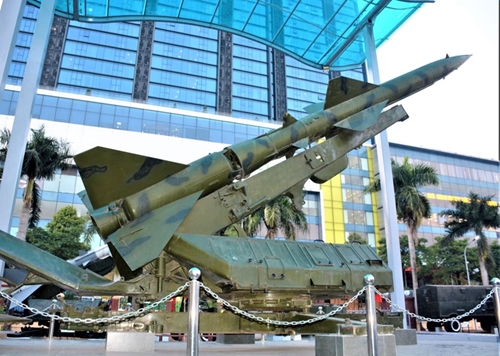The General Staff of the Vietnam People's Army directed units that "In case of the enemy using B-52s to destroy key targets, forces including anti-aircraft gun, missile, radar, artillery, and air forces should maintain combat readiness, promptly counter-attack enemy aircraft and warships. They should also observe, alert, evacuate, dig trenches, team with policemen and the people to ensure security and protect property.”
    |
 |
|
Missile launcher of Battalion 59, Regiment 261 which shot down the first B-52 in Hanoi (on December 18, 1972), which is currently on display at the Air Force - Air Defense Museum |
At 18:50, the Air Defense - Air Force Service shifted the combat readiness posture to level 1. At 19:15, Radar Company 45 (Regiment 291) detected B-52s and promptly reported that “B-52 is entering the North.” Ten minutes later, the air force was ordered to launch sorties to fight enemy tactical aircraft groups. At the same time, observatories in Tam Dao and Viet Tri detected F-111A combat aircraft bombing Noi Bai and Kep airports. The historic confrontation in the air began.
From 19:25 to 20:18, many groups of B-52s, three each, uninterruptedly dropped bombs on Noi Bai Airport, Dong Anh, Yen Vien and Gia Lam. At 19:44, the first missile of Battalion 78, Regiment 257, Division 361 was launched. At 20:13, B-52s continued to bombard. Battalions 57, 59, 94 of Regiment 261, Division 361 (now Regiment 261 of Division 367 under the Air Defense - Air Force Service) were ordered to jointly destroy the group of B-52s rushing from Tam Dao to attack depots in Dong Anh and Co Loa. The crew of Battalion 59 fired two missiles to down a B-52. That was the first B-52 shot down in the sky of Hanoi, just less than 10km from the battlefield.
The shooting down of a B-52 stratofortress - the symbol of the U.S. Air Force’s power right on the first night that the U.S. deployed them to attack Hanoi held a special meaning, relieving worries about the possibility to defeat B-52s in a timely manner, driving Vietnamese troops and people to fight.
From the night of December 18 to early morning of December 19, the U.S. Air Force mobilized 90 sorties of the B-52 to conduct three waves of bombardment on Hanoi. Together with B-52s, F-111A and contour fighters conducted eight and 127 sorties, respectively to drop some 6,600 bombs on different places across Hanoi. Vietnamese troops and people bravely fought and downed six aircraft of all kinds, including three B-52s (two crashing on the spot).
Translated by Mai Huong